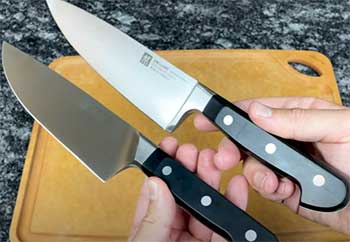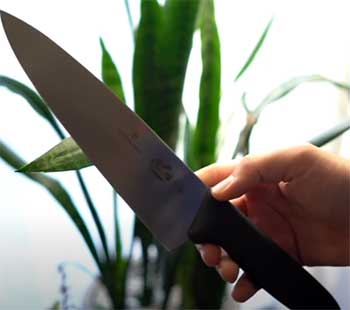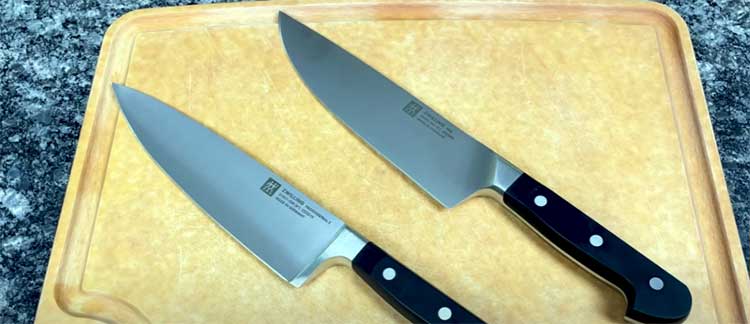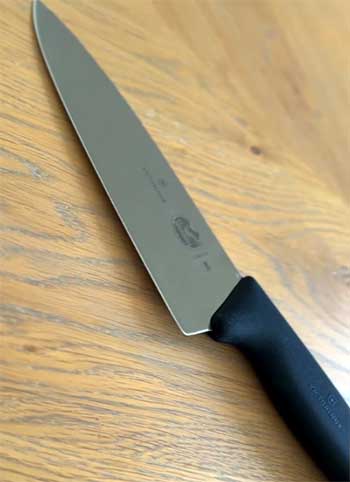I’ve spent countless hours in the kitchen, chopping, slicing, and dicing my way through recipes, and I’ve learned one thing: a good knife is your best friend. Choosing between Victorinox and Zwilling, two giants in the cutlery world, isn’t easy.
In this article, I’ll share my experience with both brands, weighing their pros and cons to help you decide which suits your cooking style.
From steel quality to handle comfort, I’ll break it all down in a way that feels like we’re chatting over coffee, ensuring you leave with clarity on your next knife purchase.
A Brief Comparison Table
| Feature | Zwilling Professional S | Victorinox Fibrox Pro |
| Country of Manufacture | Germany | Switzerland |
| Steel Type | X50CrMoV15 (Forged) | X50CrMoV15 (Stamped) |
| Rockwell Hardness | HRC 57 | HRC 56 |
| Factory Edge | 15° (Double Bevel) | 15° (Double Bevel) |
| Handle Material | POM (Thermoplastic) | TPE (Thermoplastic) |
| Price Range (8-inch Chef’s Knife) | $140–$160 | $50–$60 |
| Main Benefit | High durability, premium feel | Affordable, comfortable grip |
| Best For | Serious cooks, professionals | Budget-conscious, beginners |
My Journey With Knives
I remember the first time I held a quality chef’s knife. It was like an extension of my hand, transforming chopping onions from a chore into a joy. Over the years, I’ve used both Victorinox and Zwilling knives extensively, and each has carved its place in my kitchen.
Victorinox, the Swiss brand famous for its Swiss Army Knives, brings practicality and value. Zwilling, a German powerhouse with nearly three centuries of history, screams precision and durability.
Let’s explore what makes these brands tick and how they stack up for real-world cooking.
The Brands: A Quick Introduction

Victorinox, founded in 1884 in Ibach, Switzerland, is synonymous with the Swiss Army Knife.
Their kitchen knives, like the Fibrox Pro line, carry that same ethos of reliability and function.
Zwilling J.A. Henckels, born in 1731 in Solingen, Germany, is a titan in the cutlery world, crafting knives that blend tradition with innovation.
While Victorinox leans into affordability, Zwilling targets those willing to invest in premium quality. Both use the same steel—X50CrMoV15—but their approaches differ, and that’s where the real comparison begins.
Steel and Construction: The Heart of The Blade
Let’s talk steel, because it’s the soul of any knife. Both Victorinox and Zwilling use X50CrMoV15, a high-carbon stainless steel known for durability and rust resistance.
With 0.55% carbon, it’s strong without being brittle, and 15% chromium ensures it won’t rust unless you’re reckless.
But here’s where they diverge: Zwilling forges its blades, heating and shaping steel for a denser, harder result (HRC 57). Victorinox stamps its blades, cutting them from a sheet, which makes them lighter but slightly less robust (HRC 56).
In my kitchen, Zwilling’s forged blades feel like tanks. I’ve sliced through dense butternut squash with the Professional S chef’s knife, and it powers through with minimal effort. The extra hardness means it holds its edge longer, so I’m not sharpening it every other week.
Victorinox’s stamped blades, like the Fibrox Pro, are lighter and more flexible, which I love for quick tasks like mincing garlic. But they chip more easily if you’re not careful—I learned this the hard way with a rogue potato.
Pros of Zwilling’s Steel and Construction
- Forged blades are denser, offering superior edge retention.
- Higher Rockwell hardness (57) means less frequent sharpening.
- Full tang design adds balance and heft, ideal for heavy tasks.
Cons of Zwilling’s Steel and Construction
- Heavier weight (9.5 ounces for an 8-inch chef’s knife) can fatigue your hand during long prep sessions.
- Forging process drives up the cost, making it pricier.
Pros of Victorinox’s Steel and Construction
- Stamped blades are lightweight (6.7 ounces), great for nimble tasks.
- Same high-quality steel as Zwilling, ensuring durability and rust resistance.
- Affordable due to the stamping process.
Cons of Victorinox’s Steel and Construction
- Slightly lower hardness (HRC 56) means more frequent sharpening.
- Stamped blades can feel less premium and may chip under heavy use.
Sharpness: The Cutting Edge

A knife’s sharpness is its superpower.
Both brands start with a 15-degree double bevel edge, standard for Western-style knives.
Out of the box, they’re razor-sharp—my Zwilling sliced through paper like butter, and the Victorinox wasn’t far behind.
But Zwilling’s forged blades, with their slightly harder steel, hold that edge longer.
I noticed my Zwilling Professional S stayed sharp through weeks of daily use, while my Victorinox Fibrox Pro needed a quick hone after a couple of intense chopping sessions.
For precision tasks, like julienning carrots, Zwilling’s edge gives me confidence. Its heft and sharpness make clean, consistent cuts. Victorinox, being lighter, excels at speedier tasks, like dicing herbs, but I’ve found it dulls faster on tougher ingredients.
If you’re diligent about maintenance, Victorinox’s edge is plenty sharp, but Zwilling wins for longevity.
Pros of Zwilling’s Sharpness
- Holds edge longer due to harder steel.
- Ideal for precise, clean cuts on a variety of ingredients.
Cons of Zwilling’s Sharpness
- Requires skill to sharpen properly due to harder steel.
- Initial sharpness isn’t noticeably better than Victorinox.
Pros of Victorinox’s Sharpness
- Razor-sharp out of the box, great for immediate use.
- Easier to sharpen due to slightly softer steel.
Cons of Victorinox’s Sharpness
- Loses edge faster, especially with frequent use.
- May struggle slightly with very hard ingredients.
Handle Design: Grip and Comfort

A knife’s handle is where comfort meets control. Zwilling’s Professional S uses POM (polyoxymethylene), a rigid thermoplastic that feels solid and withstands moisture and heat.
Its curved, ergonomic shape fits my hand like a glove, especially when I use a pinch grip for chopping. Victorinox’s Fibrox Pro uses TPE (thermoplastic elastomer), which is softer and grippier, even when wet.
I’ve found the Fibrox handle incredibly comfortable for long sessions, though it looks less refined than Zwilling’s sleek design.
I once spent an hour prepping vegetables with the Victorinox, and the non-slip grip was a lifesaver when my hands were slick with olive oil. Zwilling’s handle, while sturdy, can feel a bit stiff during marathon sessions.
Victorinox also offers a Rosewood handle option, which I find stunning but less practical due to maintenance needs. Zwilling’s POM handle, with its full tang, adds balance but makes the knife heavier, which might not suit everyone.
Pros of Zwilling’s Handle
- POM is ultra-durable and resistant to kitchen wear.
- Ergonomic shape supports precise control, especially for pinch grips.
- Full tang enhances balance.
Cons of Zwilling’s Handle
- Heavier handle can cause fatigue over time.
- Less grippy when wet compared to Victorinox.
Pros of Victorinox’s Handle
- TPE offers excellent grip, even in wet conditions.
- Lightweight design reduces hand fatigue.
- Rosewood option adds aesthetic appeal.
Cons of Victorinox’s Handle
- TPE feels less premium than Zwilling’s POM.
- Rosewood requires more care to maintain.
Price and Value: Bang for Your Buck
Price is where these brands really part ways. A Zwilling Professional S 8-inch chef’s knife runs $140–$160, reflecting its forged construction and premium materials. Victorinox’s Fibrox Pro, at $50–$60, is a steal for its quality.
I bought my Victorinox as a budget-friendly starter knife, and it’s served me well for years. Zwilling, on the other hand, feels like an investment—something you buy when you’re ready to elevate your game.
For beginners or those on a budget, Victorinox offers unbeatable value. Its performance rivals pricier brands, and you can outfit your kitchen without breaking the bank.
Zwilling’s higher cost comes with a premium feel and longevity, making it worth it for serious cooks. I’ve found both brands justify their price, but your wallet and cooking habits will dictate the better choice.
Pros of Zwilling’s Price and Value
- Premium quality justifies the cost for dedicated cooks.
- Lifetime warranty adds long-term value.
- Resale value holds better due to brand prestige.
Cons of Zwilling’s Price and Value
- High cost can be prohibitive for casual cooks.
- Not significantly better than Victorinox for basic tasks.
Pros of Victorinox’s Price and Value
- Exceptional value for high-quality performance.
- Affordable for beginners and pros alike.
- Reliable for everyday use without breaking the bank.
Cons of Victorinox’s Price and Value
- Lacks the premium aesthetic of higher-end brands.
- May need replacing sooner due to stamped construction.
Performance In The Kitchen: Real-World Testing

Let’s get to the fun part: how these knives perform.
I’ve put both through their paces, from slicing tomatoes to breaking down chickens.
Zwilling’s heft and balance make it a beast for heavy-duty tasks.
I carved a roast with the Professional S, and the blade glided through with precision, no sawing required.
Its curved blade is perfect for a rocking motion, ideal for chopping herbs or vegetables.
Victorinox’s lighter Fibrox Pro shines for quick, repetitive tasks.
I diced a pile of onions in record time, and the lightweight blade kept my hand fresh.
However, it struggled slightly with denser foods like sweet potatoes, requiring more force.
Zwilling’s forged blade handled those with ease, but its weight made me pause during long sessions. Your cooking style—fast and light or deliberate and powerful—will tip the scales here.
Pros of Zwilling’s Performance
- Excels at heavy tasks like cutting through meat or dense vegetables.
- Balanced design enhances control for precise cuts.
- Durable edge reduces maintenance time.
Cons of Zwilling’s Performance
- Heavier weight can tire you out during extended use.
- Overkill for simple tasks like peeling or mincing.
Pros of Victorinox’s Performance
- Lightweight and nimble for quick, repetitive cuts.
- Comfortable for long prep sessions.
- Performs well across a range of tasks for the price.
Cons of Victorinox’s Performance
- Less effective on very hard or dense ingredients.
- Edge dulls faster, requiring more frequent honing.
Design and Aesthetics: Looking the Part
A knife’s look matters, especially if you display it on a magnetic strip. Zwilling’s Professional S has a classic, elegant design with its triple-riveted POM handle and polished blade. It screams “professional kitchen” and feels like a status symbol. Victorinox’s Fibrox Pro, with its black TPE handle, looks utilitarian—functional but not flashy. The Rosewood version is prettier but less common.
In my kitchen, the Zwilling turns heads when guests see it. It’s a conversation starter, exuding craftsmanship. Victorinox’s Fibrox Pro is more understated, but I appreciate its no-nonsense vibe. If aesthetics matter to you, Zwilling wins; if you prioritize function over form, Victorinox holds its own.
Pros of Zwilling’s Design
- Sleek, professional aesthetic elevates kitchen vibe.
- Triple-riveted handle adds a timeless look.
- Forged construction enhances perceived quality.
Cons of Zwilling’s Design
- Classic design may feel dated to some.
- Heavier build isn’t for everyone.
Pros of Victorinox’s Design
- Functional, minimalist look suits practical cooks.
- Lightweight design prioritizes ease of use.
- Rosewood option offers a touch of elegance.
Cons of Victorinox’s Design
- Fibrox handle looks cheap compared to Zwilling.
- Less “wow” factor for display purposes.
Also Read: Comparison of Schmidt Brothers And Henckels Knives.
Durability and Maintenance: Long-Term Love
Durability is key for a knife you’ll use daily. Zwilling’s forged blades are built to last, resisting chips and wear even under heavy use. I’ve had my Professional S for years, and it’s still going strong with minimal maintenance—just regular honing and occasional sharpening.
Victorinox’s stamped blades are durable too, but they’re more prone to chipping if you’re rough. I nicked my Fibrox Pro on a bone once, and it took a bit of work to restore.
Maintenance-wise, Victorinox is easier to sharpen due to its softer steel, which is great for beginners. Zwilling requires a bit more skill but rewards you with a longer-lasting edge. Both are dishwasher-safe, but I hand-wash mine to preserve the blades. Zwilling’s lifetime warranty is a nice touch, though I’ve never needed it.
Pros of Zwilling’s Durability and Maintenance
- Forged blades resist chips and wear better.
- Lifetime warranty offers peace of mind.
- Edge retention reduces maintenance frequency.
Cons of Zwilling’s Durability and Maintenance
- Harder steel requires more sharpening skill.
- Higher initial investment.
Pros of Victorinox’s Durability and Maintenance
- Easy to sharpen, ideal for beginners.
- Durable for the price, with proper care.
- Low cost makes replacement less painful.
Cons of Victorinox’s Durability and Maintenance
- Stamped blades chip more easily under stress.
- Requires more frequent honing.
Who Should Choose Which?
Your choice depends on your cooking style and budget. If you’re a serious home cook or professional who values durability and a premium feel, Zwilling is your pick. Its forged blades and balanced design make it a workhorse for heavy tasks.
If you’re a beginner, on a budget, or prefer a lightweight knife for quick prep, Victorinox is hard to beat. Its value and comfort are unmatched for the price.
I lean toward Zwilling for big projects, like holiday roasts, but I grab my Victorinox for everyday chopping. Both have earned their place in my kitchen, and I suspect you’ll find a similar balance based on your needs.
Also Read: Comparison of Inkosi And Sebenza Knives.
Frequently Asked Questions (FAQ)
Yes, Zwilling knives, especially the Professional S and Pro lines, are considered high-end due to their forged construction, premium materials, and superior durability.
Absolutely, Victorinox knives offer excellent quality, especially for their price. The Fibrox Pro line is sharp, durable, and trusted by many professional chefs.
Zwilling J.A. Henckels is the premium brand, with higher quality and German-made forged knives. Henckels (without “Zwilling”) often refers to lower-tier, non-German-made knives under the same parent company.
No, Victorinox kitchen knives are made in Ibach, Switzerland, maintaining their reputation for Swiss craftsmanship.
Conclusion: Your Knife, Your Choice
After years of slicing, dicing, and chopping, I’ve come to love both Victorinox and Zwilling for different reasons. Zwilling’s premium heft and durability make it a dream for serious cooks, while Victorinox’s affordability and lightweight design are perfect for everyday tasks.
You can’t go wrong with either, but your choice hinges on what you value—luxury and longevity or value and versatility. Pick the one that feels right in your hand and fits your budget, and you’ll be chopping like a pro in no time.
